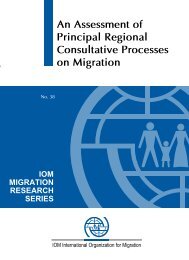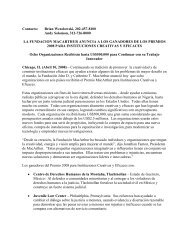A Global Compact on Learning - Brookings Institution
A Global Compact on Learning - Brookings Institution
A Global Compact on Learning - Brookings Institution
Create successful ePaper yourself
Turn your PDF publications into a flip-book with our unique Google optimized e-Paper software.
5<br />
Strategies comm<strong>on</strong> to all three<br />
priorities<br />
Good teachers and assessment systems are fundamental<br />
for making progress <strong>on</strong> each of the three policy<br />
priorities discussed in the previous three chapters.<br />
For this reas<strong>on</strong>, these two factors are discussed in detail<br />
here as two specific strategies that apply equally to<br />
improving early childhood development, to literacy<br />
and numeracy in the lower primary grades, and to<br />
relevant post-primary learning. Investing in teachers,<br />
particularly female teachers, and improved measurement<br />
are also essential elements of ensuring that the<br />
most marginalized children, especially poor girls,<br />
share in the benefits of learning (see figure 5.1).<br />
Comm<strong>on</strong> Strategy 1: Improve the Quality of<br />
Teaching<br />
Many studies identify how teachers teach and how<br />
much time they spend teaching as the most powerful<br />
determinants of children’s achievement in<br />
low-income countries. Studies have shown that<br />
the quality of teachers is not necessarily defined as<br />
holding an advanced teaching degree but instead as<br />
being adequately prepared, supported, motivated,<br />
and compensated to teach. This goal also extends<br />
to other educati<strong>on</strong>al pers<strong>on</strong>nel, particularly including<br />
head teachers and principals, who are critical in<br />
leading and managing schools.<br />
To improve the quality of teaching, four acti<strong>on</strong>s<br />
should be taken:<br />
• Recruit and train more female teachers,<br />
particularly at the sec<strong>on</strong>dary level.<br />
• Adequately prepare teachers.<br />
• Motivate and support teachers.<br />
• Strengthen school leadership and management.<br />
The first needed acti<strong>on</strong> is to recruit and train more<br />
female teachers, particularly at the sec<strong>on</strong>dary level.<br />
The presence of female teachers has been shown to<br />
not <strong>on</strong>ly boost enrollment and reduce dropout rates<br />
but also improve learning outcomes for girls. 217 This<br />
can be particularly important for adolescent girls. In<br />
Sub-Saharan Africa, female teachers rarely exceed 25<br />
percent in sec<strong>on</strong>dary school, with far fewer teachers<br />
in rural areas. 218 In Bangladesh, having female<br />
teachers in local schools was found to increase girls’<br />
enrollment, 219 and increase the percentage of correct<br />
answers in sec<strong>on</strong>dary-level mathematics. 220 In a fivecountry<br />
African study, fifth-grade girls’ knowledge<br />
gains were larger when taught by a female teacher,<br />
whereas boys benefited more from a male teacher. 221<br />
However, female teachers also require gender sensitive<br />
training; <strong>on</strong>e study in Kenya found that they<br />
can be even more biased against girls. 222 In some<br />
countries, quotas might be necessary to increase the<br />
number of female teachers, especially in positi<strong>on</strong>s of<br />
leadership. Kenya increased the number of female<br />
head teachers from 10 to 23 percent during a tenyear<br />
period by requiring that <strong>on</strong>e out of two head<br />
teachers being trained be a woman. 223 Given the low<br />
literacy rates of women in many countries, finding<br />
qualified female teachers can be difficult. However,<br />
studies have found that even very young women<br />
can teach programmed curricula effectively as l<strong>on</strong>g<br />
as they are properly trained and supported. 224 Tanzania<br />
successfully expanded the number of teachers<br />
by licensing sec<strong>on</strong>dary school graduates who are deployed<br />
to schools after <strong>on</strong>e m<strong>on</strong>th’s training <strong>on</strong> the<br />
c<strong>on</strong>diti<strong>on</strong> that they enroll in a degree program with<br />
the Open University of Tanzania while they c<strong>on</strong>tinue<br />
teaching. 225 Other effective strategies to recruit more<br />
female teachers to rural areas include deploying<br />
A <str<strong>on</strong>g>Global</str<strong>on</strong>g> Compa c t <strong>on</strong> <strong>Learning</strong>: Taking Acti<strong>on</strong> <strong>on</strong> Educat i o n in Developing Countries<br />
C e n t e r for Universal Educat i o n at <strong>Brookings</strong><br />
42






